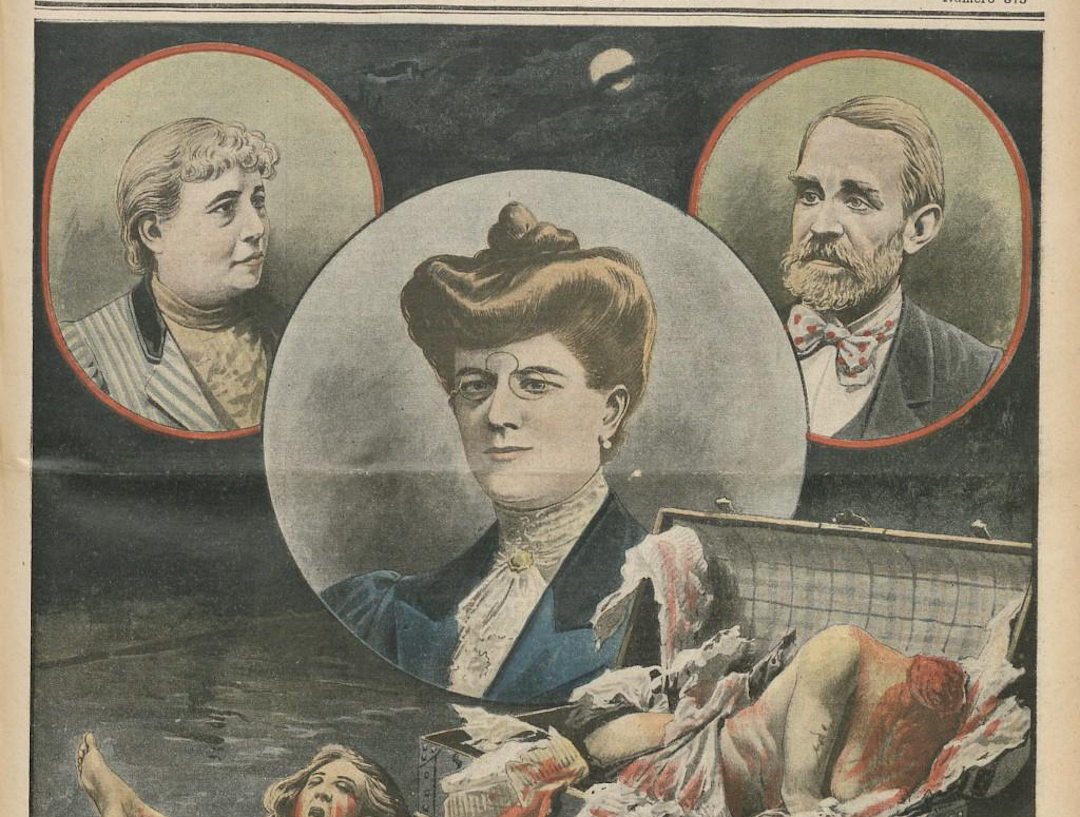On Aug. 6, 1907, a porter named Louis Pons was working his usual shift at the train station in Marseille.It always was a busy place to be, what would come to be called in later years a “transportation hub.” It was the gateway to a number of places, including French North Africa and Great Britain. It drew a lot of rollers, high and low, going to and from the grand casino in Monte Carlo. Many of the transactions among the people who passed through Marseille were perfectly legitimate, and many were perfectly … not. Porters like Pons had to be alert for low-rolling scoundrels because not only were these miscreants breaking the law, but also because the average porter in Marseille could be convinced to look the other way in order to supplement his wages with the occasional bribe or three.
However, on this hot August day in 1907, Pons spotted something he’d never seen before. Earlier, a charming Irish gentleman and his grim-faced wife had stepped off a train from Monaco and they had asked Pons to arrange for their luggage to be transported to the hotel in Marseille where they would be resting before the last stage of their trip back to London. While Pons was moving their belongings to a cab, he noticed two things. The first was that the luggage stank, horribly. The second was that the couple’s trunk apparently was bleeding. Blood oozed from it. Pons was so alarmed that he followed the couple, and their bleeding luggage, to the hotel, where he demanded to know what was going on, and threatened to go to the police. The Irish gentleman told Pons that the blood came from some slaughtered chickens that he had placed in his trunk.
Alas for him, Mme. Pons didn’t raise no imbeciles. Pons demanded the couple go to the police station with him. So the couple tried the next medium of exchange common to Marseille. They offered Pons a bribe. Accounts differ as to whether Pons accepted it but, if he did, he swindled the couple because he called the cops anyway. They came to the hotel and opened the trunk. In it, they found no dead chickens, but the various pieces of a woman, naked and disemboweled. Her head and legs were missing, but only briefly, because the police found them in a nearby valise.
Taken all in all, they added up to the late Emma Levin, a wealthy Swedish widow who had fallen in with evil company in Monaco, which was the last place anyone saw Emma Levin, intact anyway. The couple, an Irish aristocrat and one time tennis champion named Vere St. Leger Goold and his wife, Marie Giraudin Goold, and thus, in a baroque and garish public trial, ended the public life of the only Irish player to reach a Wimbledon final. He ended his life entirely while imprisoned. On Devil’s Island.
Irish tennis has fallen on hard times in one way or another for most of the past two centuries. It ruled in the 1890’s; Irish players won nine Wimbledon titles in that period, as well as two Olympic gold medals. But it was primarily the sport of the Anglo-Irish aristocracy, and the years between 1900 and 1921 were not good years for those folks. Nevertheless, the Irish Open once was reckoned to be on a par with Wimbledon and, as recently as the 1960’s and 1970’s, it was won by the likes of Tony Roche, Rod Laver, Evonne Goolagong, and Billie Jean King. Its first men’s champion was Vere St. Leger Goold, who defeated Charles David Barry, 8-6, 8-6, in 1879.
Goold was a child of that aforementioned aristocracy. He was the son of a baron from Tipperary and a great-grandson of the Earl of Kenmare. He hunted and sailed and rode horses. By all accounts, he was handsome and strong and an enormously charismatic athlete, excelling at boxing as well as at tennis. He also was not averse to the occasional wager, including on himself, which will become important to this story later.
On the court, he was as flashy a shotmaker as tennis in that era allowed. In 1879, after winning the first Irish Open, Goold went to London to compete at Wimbledon. He cruised into the finals while, reportedly, drinking the town completely dry every night. As proof that god has a sense of humor, and is a vengeful bastard besides, Goold’s opponent in the men’s final was the Reverend John Tharleycross Hartley, an Episcopal clergyman. On the day before their match, Hartley did his regular Sunday turn in the pulpit of his country church in Burneston. Goold, on the other hand, did his regular daily tour of London’s public houses, partying until late on Sunday night.
The next day, when he and Hartley faced off for the Wimbledon championship, Goold was suffering from the Los Alamos of hangovers. Even the spectators noticed it. Even Hartley noticed it. Goold lost, in straight sets, 6-2, 6-4, 6-4. (To his credit, Goold rallied and won the match that determined second place.) The next year, Goold lost in the final of the Irish Open and that pretty much was the end of his tennis career. Thereafter, he dedicated himself to drinking, and to opium, and to gambling, and he wasn’t really good at any of them. By 1891, he was broke and wandering Europe. Which is when he met a twice-widowed dressmaker named Marie Giraudin. She was a perfect match, if you planned to end your life on Devil’s Island after trying to smuggle body parts past the watchful eyes of a train station porter.
Historians differ on the circumstances of how Mme. Giraudin came to be twice-widowed. Nonetheless, by the time she and Goold got married in 1891, she saw in his aristocratic background a ticket up the social ladder, even though Goold stood to inherit virtually nothing, since he was his father’s fifth child. And she was nothing if not a climber. She and Goold invested whatever profits her dressmaking firm made in the high life. He drank them away. They both gambled them away. They bounced around between Great Britain and Canada, always one step ahead of a battalion of outraged creditors. Finally, in 1904, they were living in Liverpool when Vere St. Leger Goold had his last great idea.
In 1907, Goold bought a roulette wheel and convinced himself that, by studying it, he could devise a way to beat the game in the grand casino of Monte Carlo. (Did I mention that he drank like a fish and used opium?) Even more unfortunately, Goold believed he’d done so. So he and Marie, now traveling as Sir Vere and Lady Goold, made for Monaco, where they rented the Villa Menesini and joined the local high society set. Asked about how he, a fifth child, got to adopt a heraldic title, Goold told people that he’d inherited it when his older brother had died young in a fall from a horse. Years later, this came as some surprise to the brother, who was living in Australia at the time.
The couple then brought their foolproof roulette system into play in the casino and cratered almost immediately. As luck would have it, the putative Lady Goold latched on to Emma Levin who, I have to admit, seems to have walked through the last months of her life wearing a sign that said, “Easy mark.” She wandered the casino floor swathed in diamonds which, to the Goolds, was like ringing the dinner bell. They became friends and Levin lent the Goulds 1,000 francs, which they used to keep gambling and losing.
However, Lady Goold wasn’t the only one milking Levin. There was a certain Madame Castellazi riding the gravy train as well. One night, Lady Goold and Madame Castellazi got in a screaming match on the floor of the casino. This contretemps made the public prints and so embarrassed Emma Levin that she made immediate plans to take her diamonds and go home to Sweden. But first, she told Lady Goold, she’d like to have her 1,000 francs back and would drop by the Villa Menensini that night to pick it up. On August 4, 1907, she went to the Goolds and that was the last time anyone saw her until Pons saw her blood leaking out of a steamer trunk.
Give Vere St. Leger Goold this: He never lost all of his Tipperary chivalry. At first, he told the police that he had killed Levin in drunken and drug-fueled rage, a transparent attempt to shield his wife, who bore the marks of a ferocious struggle. The trial was an international sensation — “The Monte Carlo Trunk Murder.” Gradually, the evidence mounted that it had been Marie who had committed the actual murder, and that her husband’s involvement consisted of helping dismember the body — when he finally sobered up enough to do it — and of disposing of the viscera on a nearby beach. The judges certainly became convinced that a) Marie had been the murderer and b) Vere had been so drunk, stoned, and henpecked that he did whatever his murderous spouse told him to do. The newspapers screamed about “Lady Macbeth!,” which didn’t help Marie’s cause at all. Consequently, at the end, Marie was sentenced to the guillotine while Vere was shipped off to French Guyana, which was considered to be a lesser penalty, which was ridiculous at the time and looks even worse from the vantage point of history. He killed himself there in 1909 while Marie, being held pending an endless appeal, died of typhoid in a French prison five years later.
Now, Tennis Babylon has always been a bustling place in sports history. There has been match-fixing, doping and, in the 1990’s, several books were written describing at least the men’s tour as something between a Roman bacchanal and a Led Zeppelin tour. But the scandals touched the famous and the obscure; for example, in 2010, a player named Daniel Koellerer was choked during a changeover by his opponent, a player named Stefan Koubek. Koelllerer now is under a lifetime ban for match-fixing. That’s a helluva CV for a player of whom nobody ever heard.
None of them come close to the saga of Vere St. Leger Gould, the last Irish Wimbledon finalist who, incidentally, lost that final match in 1897 to the only ordained clergyman ever to win a Grand Slam title, and who found himself one hot August day in 1907, trying to explain why there was a torso in his steamer trunk and a head in his valise. There’s never been a bribe big enough for that.






